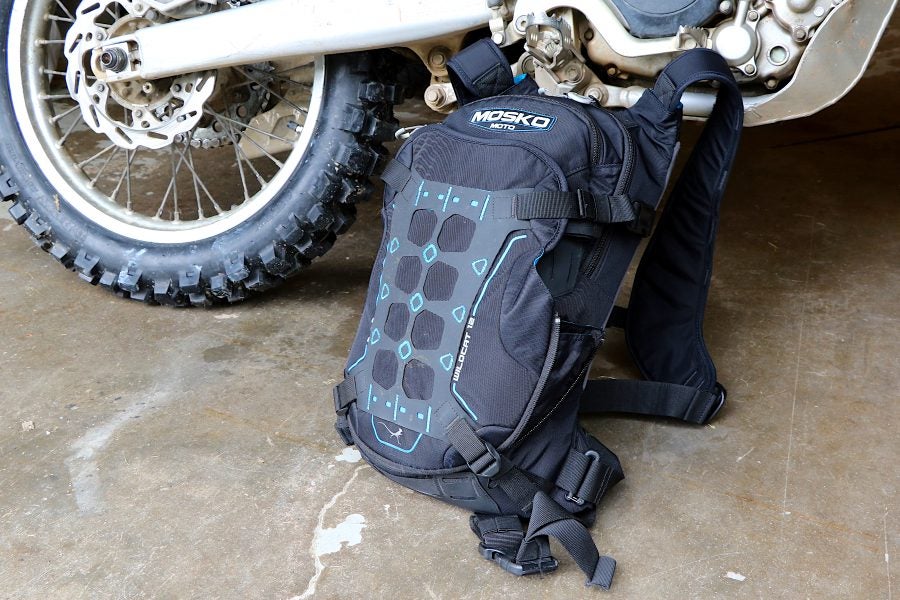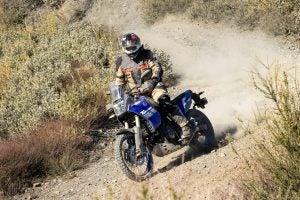Over the past few years, we’ve seen a steady increase in the number of backpacks that are specifically sold for the motorcycle market. Mosko Moto’s Wildcat series is one of the more interesting ones this season (technically, it was introduced late last season, in August of 2022). I’m always interested to test the results when a company tries an out-of-the-box idea, so I contacted Mosko Moto early this year to see if they’d send me the Wildcat 12L for testing. I’ve been using it for most of the riding season so far; here’s what I think, after thousand of miles with this equipment.

The chest rig (seen attached here) allows you to keep a pen, notebook, small camera, or receipts handy. Photo: Mosko Moto
A different layout
First, the Wildcat itself is fairly standard in its design, with a set of shoulder straps equipped with dual sternum buckles as well as a waist strap to help keep everything in place. Of course, all the straps are adjustable for a comfortable, stable and tight-to-the-body fit. One shoulder strap has a slot to hold an InReach Mini satellite beacon, which is a useful feature for riders who carry that emergency equipment.
The Wildcat has a pre-curved back panel. The main compartment is designed to carry an included 3L hydration bladder (with some room left over for other gear). There’s also a google pouch atop the pack, and a smaller tool compartment. Then, there’s what Mosko Moto calls the “Beavertail.” This is an expandable compartment with an open top; it can be left empty, and cinched tight, or stuffed with gear and opened to significantly increase the bag’s capacity.

Two separate pieces; the chest rig is optional, and many riders may not feel the need to keep things handy up-front. The chest rig adds $60 to the MSRP of this pack. Photo: Mosko Moto
All useful features, but also ideas that other manufacturers have implemented. The Wildcat backpack’s unique feature is the optional chest rig. This compartment attaches to the front of the shoulder straps, allowing you to carry small pieces of equipment in an easily-reachable location. It can also be attached to the pack’s exterior, via MOLLE webbing.
The pack is made of 630-denier water-repellent nylon (a rain cover is sold separately). Pricing starts at $239 USD for the 12L backpack, or $219 for the 8L version. The chest rig add-on is $70; the rain cover is $35.
How does it work?
Some of the most useful motorcycle gear I’ve tested has been equipment designed to solve problems encountered by the designer, answering questions like: “How can I put rackless luggage on a dirt bike?” Or, “How can I wear business attire under a riding suit?” Or, “How can I talk to friends and listen to music while I ride?”…
In the case of the Wildcat backpack, I suspect its design is very much a result of Mosko Moto staff helping scout Backcountry Discover Routes. This isn’t a piece of luggage that’s really designed for hauling your travel equipment, such as a tent, spare clothes, etc.; or at least, that’s not what it feels like when you’re using it. It feels like it’s designed to haul the stuff you use throughout a day’s riding, especially if you’re off-road in changing weather conditions.

Behold the “Beavertail” in action. The pack can be expanded for gear you don’t mind exposing to the elements, as seen here. This is a good way to stow your raincoat, etc, for days on the trail. Photo: Mosko Moto
The chest rig compartment comes in particularly handy here, as it keeps a notebook, a pen, a digital camera, a Ziploc bag for receipts, and other compact odds and ends in a tidy, easy-to-reach location. You can even (carefully) remove objects while riding. If you want to take an in-flight camera snap, for instance, it’s easy.
The main pocket looks like it’s mostly aimed at keeping your water handy, but as I rarely ride with a hydration bladder, I used it for other gear. I typically used the “Beavertail” section for rain gear, keeping it readily-accessible in case of unexpected rain.
At one point this summer, I was actually forced to use the backpack for an overnight trip when I borrowed a bike with no luggage capacity at all (a cruiser with a solo seat). I was able to get my oversized Samsung tablet, a shaving kit, spare clothes, rain gear and some other kit into the Wildcat 12L backpack. It was tight, but it did the job, and the carefully-thought-out strap design kept my load stowed nicely. While I hate touring with only a backpack for luggage, I will say that at day’s end, I felt pretty good, definitely without the worn-out upper body that you sometimes get from carrying a heavy load at speed all day. Having your gear tight to your body and somewhat better-balanced back-to-front thanks to the chest rig was a big help.
The same is true when off-roading. I haven’t had as much opportunity as I hoped to go dirt biking this year, but on the chances I’ve had to go trail riding, I found the Wildcat was very stable. No flopping around as you hit bumps on the trail, no shifting side-to-side as you lean; it’s basically an extension of your torso.
This is where the 12-liter capacity is a good thing. While I typically would choose a bag with more space, the smallish capacity means most riders won’t load it up so much that they wear themselves out. If you want more capacity for hauling cargo on the street, I’d suggest looking at something else to start with.

At this point, Mosko Moto has new color options available, as seen here. Take a look at this photo, and you can see how the diagonal sternum straps combined with the waist belt will lock in your load. Photo: Mosko Moto
Factors to consider
The smallish capacity might turn some touring-oriented riders away, and others will be turned off by the price tag. But for many riders, neither of those points is an issue. Lots of riders dislike carrying any amount of weight on their back, and the pricing is in line with competitors’ bags.
While riding, this bag might affect your gear’s airflow, especially if you have the chest rig. The difference is probably minimal in an off-road jersey. If you’re riding in a dual sport jacket with vents on each side of the front and back, you also probably won’t notice much difference. But if you’re riding one of the new-fangled jackets with a massive central vent in front and back, you might see your cooling airflow significantly reduced. I rode most of the summer in an Alpinestars Halo Drystar jacket, and noticed a difference. This is not the backpack’s fault—it’s just a trade-off with two conflicting designs, so think about that before you buy.
Also, I think Mosko Moto could reduce the number of buckles on the front of the pack, perhaps streamlining the attachment assembly for the chest rig and using a different-size buckle from the sternum strap. The sternum strap is a single buckle closure, but as it’s the same size buckle as the corners of the chest rig, I often found myself accidentally buckling the sternum strap into the chest rig when it was time to gear up and go. A minor annoyance, but an annoyance nonetheless.

The chest rig attachment hardware, as seen here, easily comes off if you’re not using this functional feature. Photo: Zac Kurylyk
Perhaps an even better solution would be to have the chest rig split into two sections, with only a central sternum buckle required when you’re doffing the pack. I am no gear designer, so my opinions are worth what you’ve paid for them (zilch!), and I am sure Mosko has tried different configurations—I’m not saying my idea is necessarily better. But if they re-designed the chest rig that way, I’d be quite keen to see if it worked better.
Finally, I did get some scuffing of the fabric on the backpack, where it rubbed against my back while riding. I asked Mosko about this, and they said no other customers had reported this problem, so perhaps it was just some weird result of wearing this backpack on the Alpinestars jacket or the army surplus raincoat I took to Quebec.

I did get some unepected scuffing around the edges of the pack over the summer. Mosko Moto was quite surprised by this, when I told them, and said it hadn’t been a problem so far. Photo: Zac Kurylyk
But overall? I think Mosko Moto’s Wildcat design is smart, and comfortable. I expect to get plenty of use from it in the miles to come.
See more details at MoskoMoto.com here.







